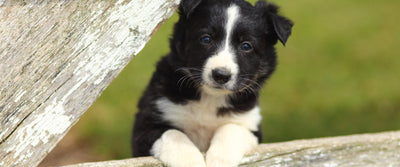Loving and loveable dog with an extraordinary sense of smell
Beagle is a small size hound that is similar in appearance to a much larger English Foxhound. Beagle is a scent hound that was developed specifically for hunting hare in packs and therefore enjoys the company.
|
|
Great Britain |
|
|
Group 6, Section 1.3 Small-sized Hounds |
|
|
Amiable, Intelligent, Determined, Excitable, Even Tempered, Gentle |
|
|
Lemon & White, Tri-color, White & Tan, Chocolate Tri, White & Chocolate, Orange & White, Red & White |
|
|
Male: 10–11 kg, Female: 9–10 kg |
|
|
Male: Male: 36–41 cm, Female: 33–38 cm |
|
|
from 12 to 15 years |
Beagle puppies
Though Beagles are intelligent, they can be single-minded and determined, which can make training them a challenge. With their exceptional sense of smell, they can easily pick up a scent and they can quickly get distracted by any smell around them. This dog breed is quite eager to please and responds well to training with treats (Agility Snacks from Husse range are great for training as well as Bravo treats that can be broken into smaller pieces), but can get bored and distracted easily. Keep training sessions with your Beagle puppy short but consistent. Feed your Beagle a high-quality diet made for medium-sized dog breed puppies - Valp Plus from Husse range supports puppies delicate digestive systems and is made with all the necessary nutrients to promote the healthy development of your Beagle puppy.


Beagle’s nutrition
Typically Beagles are active and energetic, so feeding a balanced diet suitable for medium-sized dog breeds such as Optimal from Husse range is recommended for a healthy adult Beagle. Obesity can be a common problem with Beagles, as they will eat any food they’re given in any amount. This dog breed relies heavily on the owner to regulate the food intake, so make sure to monitor your Beagle’s weight and feed the recommended daily amount for your dog’s weight. In addition, make sure to keep track of how many treats you give your Beagle, as they can add up in calories quickly. Beagles are somewhat prone to hypothyroidism and can easily gain weight, so light formulas for older or sedentary dogs of this breed will be the best bet. Optimal Light can aid in weight loss of your overweight Beagle.
Detailed description of Beagle
In general Beagle’s appearance resembles a miniature Foxhound but with a broader head, shorter muzzle and different expression.
Genesis
The origin of this ancient dog breed is not known. There are some reports of small pack-hounds that hunted rabbit and hare in England as early as year 55 B.C. From medieval times the term “beagle” was used to describe any smaller hounds. Minature beagle-type dog breeds were known as Glove Beagles since they were small enough to fit on a glove. Queen Elizabeth I kept a breed known as Pocket Beagle that was no more than 23 cm tall at the shoulder. In the 1500s most English gentlemen had both packs of large hounds for deer tracking and smaller dogs more suitable for hunting hares. It is believed that those small, compact hounds were the ancestors of modern Beagle.
Appearance
Beagles do resemble a miniature Foxhound in appearance. The main differences being smooth, domed skull with square, medium in length muzzle and a black nose. Typically this dog breed grows up to be between 33 and 41 cm high at the withers. Beagles have large brown or hazel eyes and low set and long ears that hang down to frame their face. Most commonly Beagles are tri-coloured - the coat is mostly white with a large black saddle area and brown shading around it. It is worth noting that some Beagles can gradually change colour and the black may entirely fade to brown during the course of their life.


Behaviour
Beagles are often referred to as “merry” - they are very loving, happy and companionable dogs. They make for an excellent family dog, as they get along well with children and love the company of their owners or any human they got accustomed to. This dog breed is also known for being great with other dogs and cats. If left alone for too long, Beagles can develop separation anxiety and go as far as destroying their surroundings. Dogs of this breed are curious, energetic and clever and are fond of any type of playtime that will stimulate both the mind and the body.
Requirements
Since Beagles were originally bred to work in packs they are happiest when they have company, no matter human or canine. If Beagles are left alone for prolonged periods of time they can become destructive. Always make sure to play with your adult Beagle for at least 60 to 90 minutes every day. For a senior Beagle 30 to 60 minutes of exercise should be more than enough. Beagles are somewhat of escape artists, so if kept outside in the yard make sure to install a tall fence that extends underground, since Beagles are more than capable of digging tunnels. Whenever you take your Beagle for a walk make sure to always keep him on a leash. As a scenthound with strong hunting instincts, Beagles can find it hard to resist running after a compelling smell.
Daily care
Beagle’s smooth and dense double coat sheds moderately all year round, so weekly brushing is recommended to help get rid of any dead hairs. Beagles do not require frequent bathing - it is best to give them a bath only when they get particularly dirty or bad-smelling. Don’t let your Beagle’s nails grow too long, as it can cause pain and problems with walking and running.
Dr Anna Plummer
Vet and blogger



 Country of origin:
Country of origin: FCI group:
FCI group: Temperament:
Temperament: Colors:
Colors: Weight:
Weight: Height:
Height: Life expectancy:
Life expectancy:










